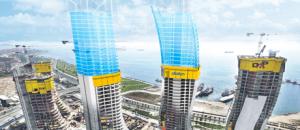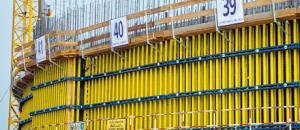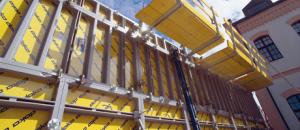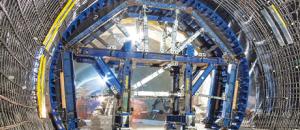
Press Contact
Impressions
But traffic is soon set to flow again. For years, construction has been underway on a new road, the Förbifart Stockholm, better known as the Stockholm Bypass. The Trafikverket, Sweden's traffic authority, has commissioned the excavation of a tunnel project under the rugged land of skerries and holms to the west of the metropolitan region for this project. A mega project. And a feat of strength too, as a good 18 kilometres of the 21-kilometre route run through the rocky underground.
Special solutions for special projects
Special projects require special solutions. It’s no coincidence that the “A-team” of Spaniards, Poles and Austrians also includes representatives from the local Doka branch, who have applied their expertise in formwork at various points of the western bypass. The main focus of their work has been two circular tunnels in the Skärholmen district, southwest of the city centre, built using the open-cut method, each 130 and 160 metres long.The Swedish team broke new ground by working on this tunnel type. Yet, in actual fact, the project only reflects why Doka is a highly sought partner for formwork in large construction projects, no matter how unique the typology. The engineers’ secret to success: adapt proven systems with special elements to on-site circumstances in such a way that concreting feels like a revelation.
The underground railway concept for cars
An example of this is using the SL-1 all-round model structure to create an SL-1 “model Stockholm bypass” structure. Because the construction of the route did not involve just any kind of tunnel – these were circular tunnels, like the ones you find in underground railways. So the team around Doka Project Manager Håkan Bratt adjusted the system and took it from the world of rail travel to the world of road travel. According to him, the local contractor Comsa received an economical rental solution intended to implement a tunnel format of this kind without complications.Of course, a design like this depends on more than just a few additional structures. Because maximising every solution to make formworking quick and easy is just as important as delivering the best solution. “We are very satisfied with the support we have received from Doka, especially Håkan Bratt and Lukas Palme. They came up with constructive ideas, always trying to optimize the solutions. They helped us to plan the formwork cycles so we were able to stay on schedule”, says Martin Klimt, Blockmanager for concrete/formwork at Comsa.
Efficiency every step of the way
But how can the formwork be quickly converted and easily moved from one place to the other? Wheels and winches provide the necessary mobility for the systems, while an on-site service for precise cutting of wooden formwork beams shortens working distances. Processes are optimised and streamlined for efficiency wherever possible.Take material use, for example: Instead of keeping two or three spares of each of the parts, their use is timed so that the construction company can manage with less material without experiencing shortages. Or safety: Here, the Edge protection system XP was chosen. "It is user-friendly and can be used universally for all edge pro¬tection needs," explains Lukas Palme, Group Leader Engineering, Doka Sweden.
An invaluable benefit, especially since the Swedish Doka branch has been entrusted with several construction sections. As well as the two circular tunnels, including entrances and exits, the work includes two 20-metre-long routes in rocky terrain as well as a pair of trough structures, the expansion of existing infrastructure and numerous stabilisation measures along the route.
A matter of form
As well as identifying the perfect solution and getting the most out of it, at least one more question is on the minds of the formwork specialists: How to position the system to make pouring concrete a piece of cake. And how Sweden's first round road tunnel is not just a matter of form. At Doka, it’s always about combining functions and innovations. About a modular system that does not only generate hardware solutions but other solutions as well.In Skärholmen the team has once again demonstrated how valuable an all-round service that is firmly embedded in Doka’s value system can be.
BIM as a “digital campfire”
Cue BIM: “We surprised Comsa with a 3D model on our initiative,” explains Jan Radlbauer, Head of Engineering Europe. Since the more complex the geometry, the more important it is to fully map the building space. Doka also drew the underlying model so that the customer could visualise it.The benefits are clear. All employees are connected via their mobile devices and therefore are always up-to-date when construction data changes or an update is available. Problems are evaluated more quickly and errors rectified more easily than if everyone had to be individually briefed on the vast construction site.
BIM 360 and the design software Revit helped visualise the challenging tunnel geometries down to the smallest detail, especially the formwork constructions. When different countries are involved, data and sketches help everyone understand what's going on. And participation means understanding. BIM is a digital bonfire at which project partners warm up every day for their tasks and discuss all manner of issues surrounding the tunnel construction.
“The BIM model was great and helped us to plan the works before execution since it gave us a unique possibility to see how everything will look in reality. This is very helpful when it comes to production and crane planning. When you combine the knowledge from a professional formwork supplier like Doka, an experienced subcontractor and our expertise the result becomes great,” says Martin Klimt, Blockmanager for concrete/formwork at Comsa.
Six construction sections, one big goal
Why, for example, a particular load-bearing tower or large-area formwork is used, or why fewer system parts are sometimes more. Every tunnel is different, at most similar only to itself. This means that experience does not mean resting on one’s laurels, but is part of a continuous learning process. Because there is always something new you can learn, a goal you can strive for.And this is how projects like the one in Sweden come into being; the country's first circular road tunnels in open-cut construction are now taking off around Stockholm; on top of that, it’s another first for the Swedish Doka team, projected in BIM.
As things stand, the six sections involving Doka will be handed over to the client on time and within budget after roughly five years of planning and construction. When the junctions between Kungens kurva in the south and Häggvik in the north are approved for traffic, as is due to happen from 2025, the Stockholm Bypass will be one of the three longest road tunnels in the world. And Stockholm will continue to be one of the best places to live.
Project: FSE215 Tpl Skärholmen
Location: Stockholm, Sweden
Method: Round and open-cut
Tunnel length: 160 m & 130 m
Project Owner: Trafikverket
Construction company: Comsa
Forming operation: 2019 to 2023
In use: Products: Framed formwork Frami and Framax, Large-area formwork Top 50, Heavy-duty supporting system SL-1, Load-bearing tower, Timber-beam floor formwork Dokaflex, Edge protection system XP
Services: Planning, BIM, On-site service, Pre-assembly service
Products and Solutions in use
This could also be of interest for you:
Do you have any questions on the article? Get in touch with us!












